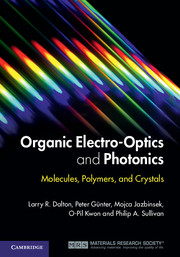Book contents
- Frontmatter
- Dedication
- Contents
- 1 Introduction
- 2 Nonlinear optical effects
- 3 Electro-optic effects
- 4 Molecular nonlinear optics
- 5 Acentric self-assembled films
- 6 Crystalline materials
- 7 Electrically poled organic materials and thermo-optic materials
- 8 Overview of applications
- 9 Organic electro-optic waveguides, switches, and modulators
- 10 Nonlinear optical infrared and terahertz frequency conversion
- 11 Photorefractive effect and materials
- 12 Conclusions and future prospects
- Index
- References
8 - Overview of applications
Published online by Cambridge University Press: 05 August 2015
- Frontmatter
- Dedication
- Contents
- 1 Introduction
- 2 Nonlinear optical effects
- 3 Electro-optic effects
- 4 Molecular nonlinear optics
- 5 Acentric self-assembled films
- 6 Crystalline materials
- 7 Electrically poled organic materials and thermo-optic materials
- 8 Overview of applications
- 9 Organic electro-optic waveguides, switches, and modulators
- 10 Nonlinear optical infrared and terahertz frequency conversion
- 11 Photorefractive effect and materials
- 12 Conclusions and future prospects
- Index
- References
Summary
In this chapter, an overview of applications of electro-optics is presented. Waveguide electro-optic devices are discussed in greater detail in Chapter 9 and applications involving second-order nonlinear optical effects other than electro-optic phenomena (e.g., frequency conversion) are discussed in Chapter 10. Photorefractivity phenomena, materials, and applications are discussed in Chapter 11. Some prototype devices, particularly silicon–organic hybrid (SOH) and plasmonic–organic hybrid (POH) devices, were briefly discussed in Chapter 7.
Device parameters and materials requirements
Applications of electro-optic materials include telecommunications, computing, defense, medical, and sensing technologies. A wide range of specific devices are critical for these technologies. Electro-optic devices can be divided into three general categories: (1) stripline devices such as Mach–Zehnder interferometers and directional couplers; (2) resonant devices such as ring microresonators, etalons, photonic crystal, and metamaterial devices; and (3) prism-based devices such as spatial light modulators. The relationships between device performance and material performance parameters vary with device type. Some properties, such as acceptable material optical loss, depend on system architectures, as well as individual device architectures. Material requirements, such as thermal and photochemical stability, will depend upon device and system operating conditions, e.g., temperature and optical power levels that are used. Telcordia standards define minimum thermal stability requirements, e.g., long-term operational stability at 85 °C (and 85% humidity). Optical power levels vary with application area, e.g., telecommunication applications currently utilize power levels of 10–20 mW at wavelengths centered around 1.3 or 1.55 μm.
Clearly, material requirements and their relationship to device performance will depend upon application and upon device and system architectures, so general and simple requirements cannot be defined in a meaningful way. However, in the following, we provide insight into the relationship between device performance and materials characteristics for the simple general device structures noted above. A more in-depth discussion relevant to waveguide device architectures is presented in the next chapter. An even broader range of device architectures are relevant to the applications discussed in Chapters 10 and 11.
Stripline devices. Representative stripline devices include Mach–Zehnder interferometers (amplitude modulators), birefringement or phase modulators, and directional couplers (see Figs. 9.6 and 9.8) [1,2].
- Type
- Chapter
- Information
- Organic Electro-Optics and PhotonicsMolecules, Polymers and Crystals, pp. 175 - 187Publisher: Cambridge University PressPrint publication year: 2015



